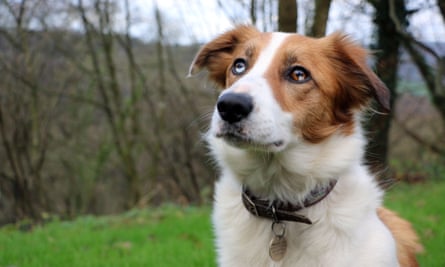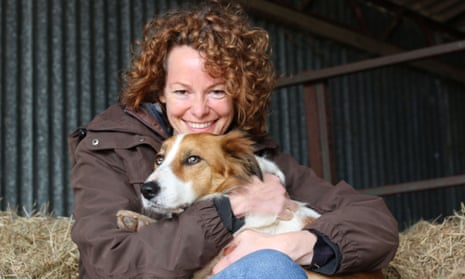Kate Humble is looking for a husband, and I think she might have found one deep in the Welsh forests. Simon and his dog are rounding up rogue sheep who have escaped their flock and gone feral. He looks like a 19th-century bounty hunter – beefy, with braces and a mutton-chop beard, able to lift a huge sheep over one shoulder, no problem. “There’s another potential husband,” says Humble, twinkling. “Not Simon, obviously. He’s married. For Teg. Tango, I mean.” Teg is Humble’s dog; Tango belongs to Simon.
Kate Humble: My Sheepdog & Me (BBC2) was a warming programme featuring farmhouses, glorious countryside and puppies. Two-year-old Teg is old enough to be a mum, and Humble – the most puppyish of TV presenters – hopes her pups will carry on the dwindling Welsh sheepdog line. Everyone knows the border collie, but there are about 20 breeds of herding dog and more than half of them are extinct. Welsh sheepdogs appear to be the best, but the people who rave about them are Welsh farmers, so they would say that.
There isn’t a uniform look to the breed – it’s all about their behaviour – but Teg, says Humble, “looks like a cross between David Bowie and Basil Brush”, thanks to her different coloured eyes and shagginess (not that kind of shagginess – that comes later). She’s supposed to be a working dog on Humble’s Monmouthshire farm, but she’s been allowed to become a sofa-dwelling, pampered pet. Humble needs to train her to get her recognised by the Welsh Sheepdog Society, but also in a more existential way, to fulfil her very nature. “I feel I owe it not only to her but to the Welsh sheepdog as a breed,” she says.

They spend several weeks training together and Teg successfully herds some sheep into a trailer. She looks pleased with herself and gets a tummy rub. Now the test – can she impress the society? Of course she can. But it’s not enough to act like a Welsh sheepdog. They tell Humble that because she doesn’t know her dog’s parentage, Teg can’t be registered. Her puppies might become official, but only if they can herd sheep, too. They might prefer the sofa.
Undeterred, Humble turns her attention to the subplot, ambling away in the background like a wandering sheep, which is to discover, with the help of Aberystwyth University, if the Welsh sheepdog has distinct genes – if herding is in its nature rather than nurture. And it is! Teg is 75% Welsh sheepdog and a quarter border collie. The news gets better – Tango is interested. Alas, Simon still appears to be married.
Two months later, Teg gives birth to six puppies – tiny, soft, pink little things, like mewling marshmallows. If you’re the sort of person who wells up at One Born Every Minute (and I am), it was a treat. Five of the puppies made it but one didn’t, and the shot of just its miniature paws and neat, white-tipped tail, as peacefully still as its brother and sisters were energetic, was a mournful sight.
There was little sentimentality in One Punch Killers (C5). The number of people killed by a single punch is rising, and this documentary followed the consequences: should a fatal punch be considered murder, or the unintended split-second actions of an idiotic thug? Watching this, I swung from one to the other. With immense magnanimity, Joan has become a kind of mentor to her son’s killer, Jacob. The night he killed James Hodgkinson with a single blow was “just another fight, another weekend”, he says. He served 14 months in prison and says Joan saved his life – he went back to school to get his GCSEs and A-levels, and is now doing a degree in criminology. He’s a young man, clearly mortified at his mindless action, who is looking to spend the rest of his life trying to make up for it.

But then there’s the man who killed Robert Holland. Robert’s mother, Therese, is consumed with anger and sends messages to him on Facebook saying she hopes someone close to him is murdered one day so he can feel her pain. He never responds. That’s because, we find out later, he’s serving another prison sentence, this time for GBH. “It’s an absolute joke,” says Therese. “I thought he would have learned his lesson.”
It was presented by Aaron Roach Bridgeman, a performance poet and regular presenter on a youth TV channel, and this was aimed at a younger audience. He was a likeable, sympathetic guide – though I couldn’t decide if he meant to keep referring to the light sentences for these manslaughter convictions as “a slap in the face” for the victims’ families – but the film felt irritatingly superficial at times.
It was the mothers who saved it. Most affecting of all was Ann, the mother of Kyle Bartlett who was killed in a drunken fight, who described turning off her son’s life-support machine. She is a campaigner now, and must have told this story hundreds of times, but it can’t have got any easier. The way she talked – so calm, and clear-eyed – was devastating.

Comments (…)
Sign in or create your Guardian account to join the discussion